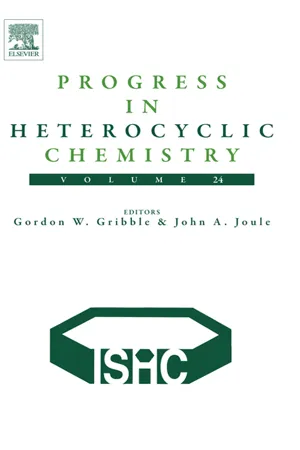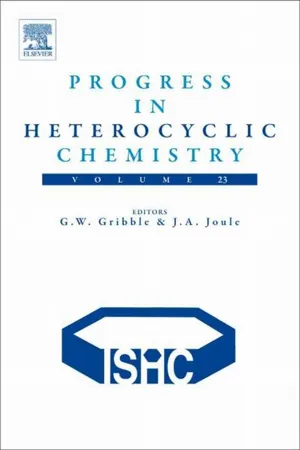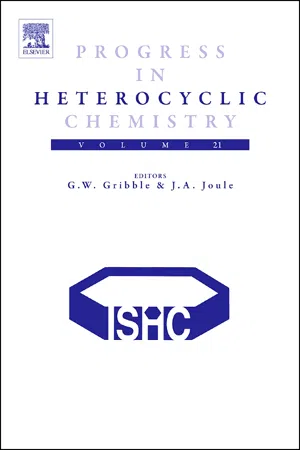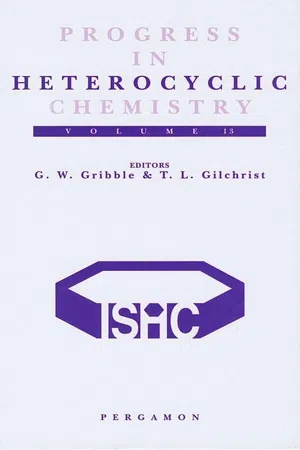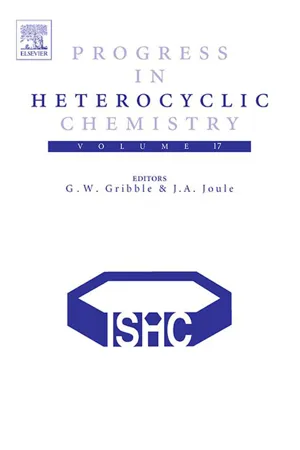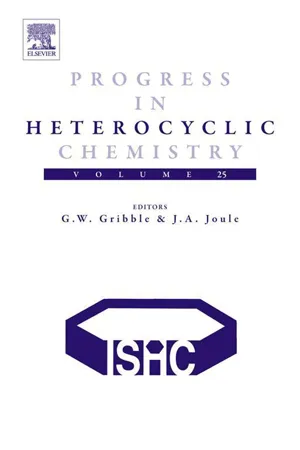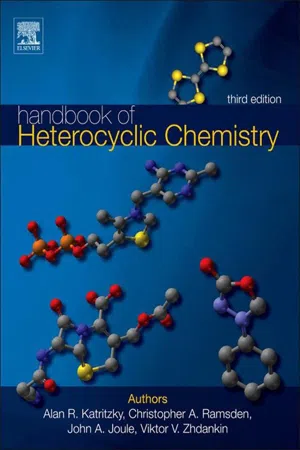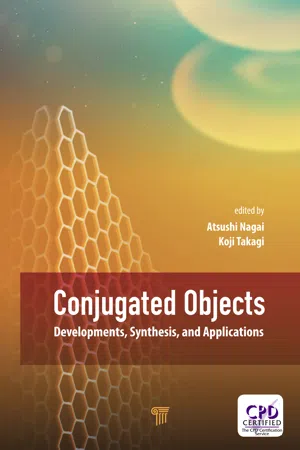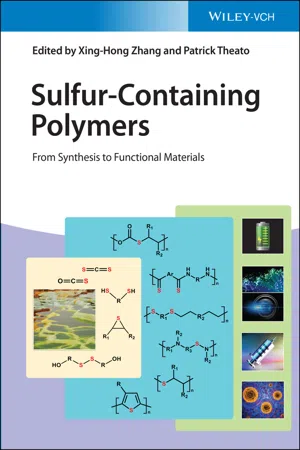Chemistry
Thiophene
Thiophene is a heterocyclic compound with a five-membered ring containing four carbon atoms and one sulfur atom. It is a colorless liquid with a strong odor and is commonly used as a building block in the synthesis of organic compounds, such as pharmaceuticals and agrochemicals. Thiophene derivatives also have applications in materials science and electronics.
Written by Perlego with AI-assistance
Related key terms
1 of 4
Related key terms
1 of 3
11 Key excerpts on "Thiophene"
- eBook - ePub
- Gordon Gribble, John A. Joule(Authors)
- 2012(Publication Date)
- Elsevier(Publisher)
b ]Thiophenes with important drug activities or for use as valuable precursors in drug synthesis. Additionally, the proper design and synthesis of Thiophenes for polymeric, electronic, superconducting, and nonlinear optical materials continued unabated this year. Due to space limitations, we will focus primarily on the synthetic aspects of Thiophene and Se/Te chemistry. Reports with a common flavor have been grouped together wherever possible.5.1.2 Reviews, Accounts, and Books on Thiophene, Selenophene, and Tellurophene Chemistry
The synthesis, properties, and biological activity of Thiophenes <11DPC38> and new developments of synthesis and reactivity of seleno- and tellurophenes have been reviewed <11OBC1301> . Reviews of the chalcogens in material sciences in 2011 include (1) how structural deviations on the backbone of conjugated polymers including poly(p -phenylenevinylene), poly(3-alkyl)Thiophenes, and poly(3-hexyl)selenophene derivatives, thieno[3,2-b ]- and thieno[3,4-b ]Thiophene-based polymers; (2) how bridge biThiophenes with 5-member fused aromatic rings in the central core influence their optoelectronic properties and photovoltaic performance <11PPS1328> ; (3) studies on long-conjugated polymers, that is, oligoThiophenes and oligoselenophenes <11ACR14> ; and (4) will polytellurophenes bridge the gap between conjugated polymers and inorganic solid-state semiconductors? <11MRC943> .5.1.3 Synthesis of Thiophenes
5.1.3.1 Thiophene Rings
Electrophilic cyclization of alkynes possessing tethered heteroatom nucleophiles and various catalytic reagents has been involved in several strategies for the synthesis of simple and complex heterocycles. Many of these strategies involve the use of palladium as metal catalyst. Recently, copper salts have been used as alternatives to palladium catalyst due to their low cost and lower toxicity. An important synthetic feature is introduced when bromine or iodine is used as electrophilic reagents since the halogen atom introduced into the heterocyclic ring can undergo a wide variety of metal-catalyzed cross-coupling reactions.Prior to this year, this methodology has been applied mainly to the synthesis of nitrogen or oxygen five-membered heterocycles. Recently, Zeni et al. have prepared a series of 3-halochalcogenophene derivatives 2 by a copper(II)-mediated intramolecular cyclization of (Z )-chalcogenoenynes 1 . Shown in Scheme 1 is the synthesis of 3-haloThiophenenes <11EJO6713> . To demonstrate the versatility of this reaction, 5-diphenyl-3-bromoselenphene 2a - eBook - ePub
- Gordon Gribble, John A. Joule(Authors)
- 2011(Publication Date)
- Elsevier(Publisher)
Chapter 5.1 Five-Membered Ring SystemsThiophenes and Se/Te Derivatives5.1.1. Introduction
A tremendous amount of synthetic effort has been expended in preparing a wide variety of Thiophenes and benzo[b ]Thiophenes with important drug activities or for use as valuable precursors in drug synthesis. Additionally, the proper design and synthesis of Thiophenes for polymeric, electronic, superconducting, and nonlinear optical materials continued unabated this year. Due to space limitations, we will focus mainly on the synthetic aspects of Thiophene and Se/Te chemistry. Reports with a common flavor have been grouped together whenever possible.5.1.2. Reviews, accounts, and books on Thiophene, selenophene, and tellurophene chemistry
The chemistry of Thiophenes has appeared in several review articles. Those involving synthesis include the synthesis of a wide variety of Thiophenes using phosphorus decasulfide (P4 S10 ) 〈10CRV3419 〉; the synthesis of heterocycles using selenoamides, selenoureas, selenazadines, and isoselenocyanates in the synthesis of selenium-containing heterocycles 〈10H(81)2027 〉; recent trends in the chemistry of aminobenzo[b ]Thiophenes 〈10JSC205 ; 10MI1〉; synthesis of thionucleosides, 〈10CRV3337 〉; combinatorial syntheses of sulfur-containing heterocycles including Thiophene using CS2 〈10JCO393 〉; recent advances in the application of the Heck reaction in synthesis of heterocyclic compounds 〈10H(81)1979 〉; synthesis of heterocycles mediated by benzotriazoles 〈10CRV1564 〉; a summary of major design and synthetic methods for tuning Thiophene-containing small molecule and polymer properties 〈10MA1533 〉. Fagnou et al . wrote the featured article in the Journal of Organic Chemistry 〈10JOC1047 〉 on moderate reactivity and direct selectivity in palladium-catalyzed heteroaromatic direct arylation using a chloprid activating/blocking group. Reviews involving the Thiophenes in materials include the key role Thiophenes and selenophenes carrying phosphorus functional groups play in construction of unique n -conjugated systems 〈B10MI1001 〉; the use of azine- and azole-functionalized oligo- and polyThiophene semiconductors for organic thin-film transistors 〈10MA1533 〉; the use of transition-metal complexes based on Thiophene–thiolene ligands on ligand synthesis and complex preparation of molecular structure and solid state properties of various compounds 〈10CCR1479 〉; recent progress in the study of electroconducting nanomaterials based on the supramolecular self-assembly of oligo(Thiophene) 〈10CSR2420 〉 and a complication of X-ray structures of a variety of Thiophenes is available 〈10AX(E)(o)271 - eBook - ePub
- Gordon Gribble, J. Joule(Authors)
- 2009(Publication Date)
- Elsevier(Publisher)
Chapter 5.1: Five-Membered Ring Systems: Thiophenes and Se/Te Analogues
Tomasz Janosik (email: [email protected] ) and Jan Bergman (email: [email protected] )
Department of Biosciences and Nutrition, Karolinska Institute, Novum Research Park, SE-141 57Huddinge, Sweden5.1.1. Introduction
The strong and continuously increasing interest in Thiophene chemistry is manifested in a multitude of new publications that appeared during the year 2008, where this important heterocycle is represented in research fields such as materials science and medicinal chemistry. Such diverse applications of Thiophene derivatives have in turn inspired further studies in Thiophene ring synthesis, as well as new developments in modifications of existing Thiophene compounds.As in previous years, there are several new reviews available. Although some of these accounts target topics associated with Thiophene-based materials, such as layers of oligoThiophenes in nanoscale electronic devices < 08ACR1098 >, polyThiophene semiconductors for transistor applications < 08CEJ4766 >, annulated oligoThiophenes < 08MC171 >, photochromic Thiophene-containing materials < 08BCJ917 >, and the use of palladium-catalyzed CH arylation and homocoupling in construction of organic materials < 08BCJ548 >, a series of chapters in the most recent edition of Comprehensive Heterocyclic Chemistry are devoted to more fundamental aspects, namely structure < 08CHC(III)625 >, reactivity < 08CHC(III)741 >, ring synthesis < 08CHC(III)843 >, as well as applications < 08CHC(III)931 >. A general review covering the development of organic semiconductors for solution-processable field-effect transistors has also been published, providing numerous references to Thiophene-based studies < 08AG(E)4070 >. Finally, a contribution detailing the advances in synthesis of fused Thiophenes by the aromatic ortho-Claisen rearrangement has also become available < 08SL2400 - eBook - ePub
Progress in Heterocyclic Chemistry
A Critical Review of the 2000 Literature Preceded by Two Chapters on Current Heterocyclic Topics
- G.W. Gribble, Thomas L. Gilchrist(Authors)
- 2001(Publication Date)
- Pergamon(Publisher)
Chapter 5.1Five-Membered Ring Systems: Thiophenes & Se, Te Analogs
Erin T. Pelkey [email protected] Stanford University, Stanford, CA, USA5.1.1 INTRODUCTION
Reports detailing the chemistry and syntheses of Thiophenes, benzo[b ]Thiophenes, and related ring systems that have appeared during the past year (Jan-Dee 2000) are the primary focus of this review. Different aspects of chemistry that involve Thiophenes have been reviewed during the past year <00AM481 , 00BCSJ1 , 00CR2537 , 00CSR109 , 00PAC1645 >.5.1.2 Thiophene RING SYNTHESIS
One general strategy for preparing the Thiophene ring system is to add sulfur to activated four carbon units. For example, treatment of the zirconocene-based oligomer 1 with sulfur chloride gave the Thiophene-based oligomer 2 by replacement of the zirconium moieties with sulfur <00AC2870 >. The synthesis of a thieno[3,4-c ]Thiophene involved the addition of sulfuryl chloride to a 3,4-dicyanomethylThiophene <00TL8843 >. The central Thiophene ring of the structurally interesting thiahelicene 4 was prepared by dilithiation of 3 with LDA followed by double displacement of bis(phenylsulfonyl) sulfide <00AC4481 >. Additional examples of Thiophene ring synthesis involving the treatment of 1,4-dicarbonyl compounds with Lawesson’s reagent appeared including a synthesis of a terThiophene <00JMAT107 >and a novel fluorophore <00CC939 >.One of the most common strategies for the preparation of Thiophenes involves the intramolecular condensation of α-thioglycolates (and related α-substituted thiols) onto adjacent carbonyls. One prominent example involved the synthesis of naturally occurring anthraThiophene pigment 7 <00OL2351 >. A novel addition-elimination of tosylate 5 with methyl thioglycolate gave 6 , which was treated with sodium methoxide to effect an intramolecular cyclization giving 7. This synthesis helped ensure that the correct structure 7 had been assigned to the natuaral product. The preparation of the peri-substituted thieno[2,3-b ]Thiophene 10 was also achieved using this type of condensation with diester 9 <00SC1695 >. The latter was prepared by treating 8 with carbon disulfide and ethyl bromoacetate. Related reaction sequences have been utilized to prepare a variety of Thiophenes including benzo[b ]Thiophene-2-carboxylates <00TL4973 , 00TL5415 >, a 2-acetylbenzo[b ]Thiophene <00H(53)1175 >, 2-trifluoromethyl-Thiophenes <00S1078 >, and benzothiazole-substituted Thiophenes <00HC94 >. A related cyclization reaction of thioacetamides with activated bromides was used to prepare cyanovinyl-substituted Thiophenes <00EJOC1327 >, Thiophene-a-carboxylates, <00EJOC3273 >and a-amine-substituted Thiophenes <00JCS(P1)4316 - eBook - ePub
- Gordon Gribble, J. Joule(Authors)
- 2005(Publication Date)
- Elsevier Science(Publisher)
Chapter 5.1Five-membered ring systems: Thiophenes and Se/Te analogues
Tomasz Janosik [email protected] ; Jan Bergman [email protected] Department of Biosciences at Novum, Karolinska Institute, Novum Research Park, SE-141 57 Huddinge, Sweden, and Södertörn University College, SE-141 04 Huddinge, Sweden5.1.1 INTRODUCTION
This chapter aims at summarizing the developments in Thiophene chemistry, including some aspects on selenophenes and tellurophenes, reported during the period of January to December 2004. The emphasis is put on the synthesis and reactivity of basic Thiophene systems. Much new chemistry in this area is currently focussing on Thiophene containing oligomeric or polymeric organic materials. Even though coverage of these developments are beyond the scope of this chapter, there are short sections devoted to these types of structures included, as well as to the applications of Thiophenes in medicinal chemistry.Several specialized reviews on Thiophene containing compounds have appeared during the year. An account on single-crystalline photochromism of thienyl- or benzo[b ]thienyl containing ethenes has been published <04BCJ195 >, while the synthesis, properties and applications of bis(ethylenethio)tetrathiafulvalenes have been reviewed in detail <04CR5289 >. Thiophene- and selenophene-based materials have also been included in a review on the recent progress in semiconductor performance of devices based on such ring systems <04CM4748 >. An account on the role of single-site catalysts in the hydrodesulfurization of Thiophenes has been provided <04JOM(689)4277 >. Fused Thiophene systems, for example thienopyridazines <04PS321 >, and thienopyrimidines <04RCB487 > have also been covered. A review concerning the chemistry and properties of benzo[b ]tellurophene, dibenzo[b ,d ]tellurophene and their derivatives has appeared <04CHE834 >. Various aspects on the aromaticity of Thiophene and its Se and Te analogs have been discussed in an account on the aromaticity of heterocyclic compounds in general <04CR2777 >. Finally, an excellent monograph detailing the best synthetic methods in Thiophene chemistry has become available <04MI1 - eBook - ePub
- (Author)
- 2013(Publication Date)
- Elsevier(Publisher)
b ]Thiophenes possessing important drug activities or for use as valuable precursors in drug synthesis. Additionally, the proper design and synthesis of Thiophenes for polymeric, electronic, superconducting, and nonlinear optical materials continued unabated this year. Due to space limitations, we will focus primarily on the synthetic aspects of Thiophene and Se/Te chemistry. Reports with a common flavor have been grouped together wherever possible.4.1.2 Reviews and Books on Thiophene, Selenophene, and Tellurophene Chemistry
Several interesting reviews have appeared this year on titled compounds. These include the synthesis, structures, and catalytic activities of several sulfur-functionalized N -heterocyclic carbine complexes of Pd(II) 〈12MOL2491〉 ; synthetic routes to chiral nonracemic and racemic dihydro- and tetrahydroThiophenes 〈12CRV2129〉 ; synthesis and applications of 2,2″6′,C ′-tetrapyridines functionalized with thienyl substituents 〈12JHC453〉 ; chemistry of acyl tropic intramolecular rearrangements of keto enamines of benzo[b ]-annelated Thiophenes, selenophenes, and tellurophenes 〈12CHE107〉 and positional selectivity in electrocyclic substitution reactions of π-excessive heterocycles were reviewed; selenophenes and tellurophenes 〈12CHE241〉 ; and synthesis of thieno[3,4-b ]pyrazines and its extended analogs from 3,4-diaminoThiophene as important building blocks for the production of conjugated materials 〈12JHC479〉 . Several books or book chapters on these chalcogens were published this year. With respect to the former, a chapter on recent advances in Thiophenes ad benzoThiophenes chemistry was published in Topics in Heterocyclic Chemistry 〈12THC347〉 . Also, a chapter on titled compounds appeared in Progress in Heterocyclic Chemistry 〈12PHC139〉 .4.1.3 Synthesis of Thiophenes, Selenophenes, and Tellurophenes
Electrophilic cyclization of alkynes possessing tethered heteroatom nucleophiles using various catalytic reagents continues to be an important strategy for the synthesis of simple and complex heterocycles. For example, as shown below, the facile synthesis of anthra[2,3-b ]Thiophene and anthra[2,3-b ]selenophene was achieved in which the key steps involved electrophilic intramolecular cyclization of 2-bromo-3-alkynylanthracene in the presence of Na2 ·9HOH sodium selenide, respectively 〈12S2102〉 - eBook - ePub
- Ghodsi Mohammadi Ziarani, Razieh Moradi, Negar Lashgari, Hendrik G. Kruger(Authors)
- 2018(Publication Date)
- Elsevier(Publisher)
Chapter 16Thiophene Dyes
Abstract
Thiophene is a heterocyclic compound consisting of a planar five-membered ring that improves the photovoltaic performance of dye-sensitized solar cells (DSSCs) (Hara et al., 2005; Dentani et al., 2009; Zhang et al., 2009; Kim et al., 2012; Naka et al., 2016; Imae et al., 2015) [1–6]. Recently a series of efficient DSSCs were reported using new sensitizers containing Thiophene unit as the spacer (Thomas et al., 2005) [7]. Thiophene-based π-conjugated oligomers and polymers have been widely used in photovoltaic cells because of their chemical and environmental stability and their electronic tunability (Cremer and Bäuerle, 2006; Cravino et al., 2006; Hiorns et al., 2006) [8–10]. Thiophene-fused polyheteroaromatic dyes have attracted increasing interest as organic semiconductors for various electronic device applications, such as organic field-effect transistors, organic photovoltaic devices, and organic light-emitting diodes (Takimiya et al., 2004; Anthony, 2006; Shinamura et al., 2011; Liang et al., 2008; Lloyd et al., 2007; Mühlbacher et al., 2006) [11–16]. In this chapter, a series of Thiophene dyes are presented.Keywords
π → π∗ transition; Electron donor; Sensitizers; Solar cells; Thiophene dyesChapter Outline- 16.1 Synthesis of Thiophene Dyes
- 16.2 Application of Thiophene Dyes
- References
16.1. Synthesis of Thiophene Dyes
Due to the application of Thiophene based dyes in dye-sensitized solar cells and photovoltaic cells [1 –16 ], several studies have been done on the synthesis of these compounds. A series of Thiophene dyes were synthesized for application in dye-sensitized solar cells (DSSCs). First, the precursor aldehydes 2a–d were prepared in fair to excellent yields (26%–84%), by Suzuki–Miyaura coupling of 5-bromothieno [3,2-b ]Thiophene-2-carbaldehyde 1 with commercially available heterocyclic boronic acids. The final push–pull conjugated dyes 3a–d were synthesized by Knoevenagel condensation of the corresponding aldehyde precursors 2a–d with cyanoacetic acid in refluxing ethanol, using piperidine as catalyst (Scheme 16.1 ) [17] . The UV–Vis spectra of dyes 3 were provided in ethanol at room temperature (Fig. 16.1 ). All dyes exhibited a strong and broad band between 364 and 433 nm that can be assigned to an intramolecular charge transfer (ICT) process between the donor and acceptor groups, which depends on the heterocyclic group linked to the thienoThiophene spacer. The addition of a 2-hexylThiophene unit, as seen in dye 3b , induced a bathochromic shift in the longest wavelength absorption of 34 nm compared with dye 3a . This result can be explained having in mind that the incorporation of an additional Thiophene ring increases the charge transfer properties in a push–pull compound because of the bathochromic effect of sulfur, the partial decrease of aromatic character of the Thiophene heterocycle, and the increase of the conjugation [18 ,19 ]. On the other hand, compound 3d , having an N -methyl pyrrole donor unit exhibited a 65 nm hypsochromic shift of absorption maxima compared with compound 3a functionalized with a Thiophene donor moiety. That can be explained by realizing that the pyrrole electron pair is involved in the aromatic system and, thus, not available for delocalization to the cyanoacetic acceptor group resulting in an increased energy gap between HOMO and LUMO orbitals [20 –22 - eBook - ePub
Palladium in Heterocyclic Chemistry
A Guide for the Synthetic Chemist
- Jie Jack Li, Gordon Gribble(Authors)
- 2006(Publication Date)
- Elsevier Science(Publisher)
10 ]. In comparison to the oxygen atom in furan, the sulfur atom in Thiophene has lower electronegativity, so its lone pair electrons are more effectively incorporated into the aromatic system. The aromaticity of Thiophene is in between that of benzene and furan. As a consequence, the difference in reactivity of α-haloThiophenes and β-haloThiophenes is not as pronounced as that of the corresponding halofurans.BenzoThiophene, like Thiophene, is a π-electron rich heterocycle. Unlike Thiophene, electrophilic attack occurs selectively at the β-position (or 3-position) [10a ,11a ]; however, substitution at the α-center (2-position) can also be achieved [11b ]. The order of positional reactivity, based on nitration, is 3 > 2 > 6 > 5 > 4 > 7 [11a ,12a ]. Also, halo-genation under acidic conditions affords the 3-halobenzoThiophene [11c ,13a ]. In terms of metalation chemistry, deprotonation occurs preferentially at the 2-position (α) [11d ,13b ]; metal–halogen exchange is also favored at the α-center over the β-center [12b ].Although Pd(II), like many transition metals, possesses strong thiophilicity which can lead to poisoning of the catalyst [14 ], a variety of Thiophenes and benzo[b ]Thiophenes have been successful cross-coupling partners [10b ,15 ].5.1 Preparation of haloThiophenes and halobenzoThiophenes
5.1.1 Direct halogenation
Direct halogenation of Thiophenes is, undoubtedly, the most commonly used method for synthesizing haloThiophenes. Treatment of 3,4-bis[(methoxycarbonyl)methyl]-Thiophene (2 ) with N-bromosuccinide NBS resulted in the monobromination product 3 , whereas treatment of 2 with bromine gave rise to the corresponding bisbromination product 4 [16 ]. Using a direct halogenation with NBS, Gronowitz et al. converted 2-methoxyThiophene to 2-methoxy-3,5-dibromoThiophene (5 ), which was subsequently transformed to 2-methoxy-3-bromoThiophene (6 ) via regioselective halogen–metal exchange at C(5) followed by quenching with H2 O [17 ]. 2-Methyl-3-bromo-5-chloroThiophene (8 ), in turn, was obtained from bromination of 2-methyl-5-chloroThiophene (7 ), derived from regioselective chlorination of 2-methylThiophene at C(5) with NCS [18 - eBook - ePub
- John A. Joule(Author)
- 2020(Publication Date)
- CRC Press(Publisher)
Thiophenes: reactions and synthesis14
The simple Thiophenes1 are stable liquids which closely resemble the corresponding benzene compounds in boiling points and even in smell. They occur in coal tar distillates – the discovery of Thiophene in coal tar benzene provides one of the classic anecdotes of organic chemistry. In the early days, colour reactions were of great value in diagnosis: an important one for benzene involved the production of a blue colour on heating with isatin (section 14.1.1.7 ) and concentrated sulfuric acid. In 1882, during a lecture-demonstration by Viktor Meyer before an undergraduate audience, this test failed, no doubt to the delight of everybody except the professor, and especially except the professor’s lecture assistant. An inquiry revealed that the lecture assistant had run out of commercial benzene and had provided a sample of benzene which he had prepared by decarboxylation of pure benzoic acid. It was thus clear that commercial benzene contained an impurity and that it was this, not benzene, which was responsible for the colour reaction. In subsequent investigations, Meyer isolated the impurity via its sulfonic acid derivative and showed it to be the first representative of a then new ring system, which was named Thiophene from theion, the Greek word for sulfur, and another Greek word phaino which means shining, a root first used in phenic acid (phenol) because of its occurrence in coal tar, a by-product of the manufacture of illuminating gas.Aromatic Thiophenes play no part in animal metabolism; biotin, one of the vitamins, is a tetrahydroThiophene, however aromatic Thiophenes do occur in some plants, in association with polyacetylenes with which they are biogenetically linked. Banminth (Pyrantel), a valuable anthelminth used in animal husbandry, is one of the few Thiophene compounds in chemotherapy. - eBook - ePub
Conjugated Objects
Developments, Synthesis, and Applications
- Atsushi Nagai, Koji Takagi(Authors)
- 2017(Publication Date)
- Jenny Stanford Publishing(Publisher)
n ]phenacene. Nevertheless, these compounds are described as heteroacenes for the sake of expedience in this chapter.Fig. 2.1 Structures of [n ]acenes, [n ]phenacenes, and [n ]helicenes.Fig. 2.2 Molecular structures of pentacyclic thienoacenes.This chapter will briefly survey [n ]acenes, [n ]heli cenes, and their heterocyclic analogues mainly from the viewpoint of synthetic methods. These compounds have been known over 100 years and been synthesized via a variety of strategies. Accordingly, there have been some excellent review articles and books which cover these compounds comprehensively. On the other hand, this chapter will describe the selected methods which have been historically significant or recently developed (mainly in this century) for the readers who become interested in fused polycyclic aromatic compounds. In addition to the synthetic methods, their properties and applications as organic functional materials are also described briefly. This chapter also covers heteroacenes and heterohelicenes containing silole or phosphole ring(s), which are not aromatic rings, since they are known to exhibit excellent optical/optoelectronic properties.2.2 [n jAcenes2.2.1 IntroductionNumerous studies on acenes have been conducted for understanding their electronic structures, stability, aromaticity as well as for developing their application to organic electronics. With an increase in the number of fused benzene rings, the highest occupied molecular orbital-lowest unoccupied molecular orbital (HOMO-LUMO) energy gaps decrease.4 In addition, the aromaticity per ring and stability are also decrease with the number of fused benzene rings. This trend can be understood qualitatively by the aromatic sextet proposed by Clar.5 According to the Clar’s theory, [n ]acenes possess only one aromatic sextet ring (Fig. 2.3 ). Thus, the aromaticity is shared among the rings, resulting in lower aromaticity per ring and lower stability for higher [n ]acenes. In fact, pentacene has been known to be very sensitive to oxygen and light to give the endoperoxide 4 or the dimer 5 (Scheme 2.1 ). The lower stability as well as low solubility of hexacene, heptacene, and higher [n ]acenes has prevented them from being isolated and well-characterized until recently. Accordingly, there have been a limited number of reports on them, and the synthesis of higher acenes is still a challenging goal.6 Although a huge number of synthetic methods have been developed for lower [n ]acenes (n < 3), this chapter will focus on higher [n ]acenes (n - eBook - ePub
Sulfur-Containing Polymers
From Synthesis to Functional Materials
- Xing-Hong Zhang, Patrick Theato(Authors)
- 2021(Publication Date)
- Wiley-VCH(Publisher)
Most of them are composed of common aromatic structural blocks, such as p -phenylenevinylene, Thiophene, fluorene, carbazole, and fused heterocyclic rings [ 2 – 5 ]. Unlike traditional insulating polymers, conjugated polymers have conductive properties, which are derived from their conjugated linkages of aromatic or heteroaromatic units. Conjugated polymers have garnered significant research attention owing to their wide applications in optoelectronic devices [ 6 – 9 ] such as organic light-emitting diode s (OLED s) [ 10 ], organic thin-film transistor s (OTFT s) [ 11, 12 ], and organic photovoltaic s (OPV s) [ 13 – 15 ]. Compared with conventional silicon-based electronic materials, conjugated polymer materials have predictable advantages in terms of processability in solution, low energy consumption, as well as reducing environmental impact [ 16, 17 ]. Today 40 years on, many conjugated polymers have been developed, and among these, polyThiophene and its derivatives, all collectively referred to as Thiophene-based polymers, represent one of the largest classes of conjugated polymer and utilized in organic electronic fields such as conducting materials, OTFTs and OPVs due to their excellent optical and electrical properties, environmental stability, ease of synthesis, and the ability to connect various groups on Thiophene's β-positions or cross-couple with other aromatic/heteroaromatic units (Figure 8.1) to make their properties tunable [ 18 – 22 ]. In particular, poly(3-hexylThiophene) (P3HT) has been the model polymer for organic semiconductor physics and devices studies relating to charge transport and film morphology due to its precision of synthesis and good π–π stacking performance. In this chapter, we focus our discussion on the recent synthetic developments of Thiophene-based polymers, followed by a short introduction on their applications as organic electronic materials. Figure 8.1 Chemical structures of a few conjugated polymers. Source: Based on Ref
Index pages curate the most relevant extracts from our library of academic textbooks. They’ve been created using an in-house natural language model (NLM), each adding context and meaning to key research topics.
Explore more topic indexes
Explore more topic indexes
1 of 6
Explore more topic indexes
1 of 4
